Bette Davis
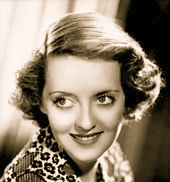
BETTE DAVIS “AN INTIMATE PORTRAIT”

Originally broadcast on September 26th, 1996 on the Lifetime network, Bette Davis: An Intimate Portrait is one of the very best documentaries ever assembled on this remarkable woman, featuring rare and timeless interview footage alongside reminiscing from her closest friends and clips from her exhilarating body of screen work. Viewed in conjunction with 1982s A Basically Benevolent Volcano and 1993s All About Bette, it completes the definitive documentary portrait of the life and career of The First Lady of the American Screen. Narrated by Lauren Hutton, the documentary features interviews with, among others, close friend Robert Wagner, film critic Susan Granger, Me & Jezebel author & playwright Liz Fuller, personal assistant Vik Greenfield , and her beloved son and proudest achievement , Michael Merrill.
 Ruth Elizabeth “Bette” Davis (April 5, 1908 – October 6, 1989) was an American actress of film, television and theater. Noted for her willingness to play unsympathetic characters, she was highly regarded for her performances in a range of film genres, from contemporary crime melodramas to historical and period films and occasional comedies, although her greatest successes were her roles in romantic dramas.
Ruth Elizabeth “Bette” Davis (April 5, 1908 – October 6, 1989) was an American actress of film, television and theater. Noted for her willingness to play unsympathetic characters, she was highly regarded for her performances in a range of film genres, from contemporary crime melodramas to historical and period films and occasional comedies, although her greatest successes were her roles in romantic dramas.
After appearing in Broadway plays, Davis moved to Hollywood in 1930, but her early films forUniversal Studios were unsuccessful. She joined Warner Bros. in 1932 and established her career with several critically acclaimed performances. In 1937, she attempted to free herself from her contract and although she lost a well-publicized legal case, it marked the beginning of the most successful period of her career. Until the late 1940s, she was one of American cinema’s most celebrated leading ladies, known for her forceful and intense style. Davis gained a reputation as a perfectionist who could be highly combative, and confrontations with studio executives, film directors and costars were often reported. Her forthright manner, clipped vocal style and ubiquitous cigarette contributed to a public persona which has often been imitated and satirized.
Davis was the co-founder of the Hollywood Canteen, and was the first female president of the Academy of Motion Picture Arts and Sciences. She won the Academy Award for Best Actresstwice, was the first person to accrue 10 Academy Award nominations for acting, and was the first woman to receive a Lifetime Achievement Award from the American Film Institute. Her career went through several periods of eclipse, and she admitted that her success had often been at the expense of her personal relationships. Married four times, she was once widowed and thrice divorced, and raised her children as a single parent. Her final years were marred by a long period of ill health, but she continued acting until shortly before her death from breast cancer, with more than 100 films, television and theater roles to her credit. In 1999, Davis was placed second, after Katharine Hepburn, on the American Film Institute’s list of the greatest female stars of all time.
Early years in Hollywood (1930–1936)
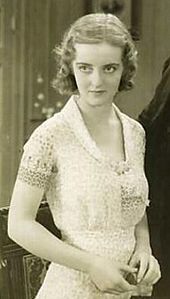 Davis in her film debut, The Bad Sister (1931)
Davis in her film debut, The Bad Sister (1931)
Accompanied by her mother, Davis traveled by train to Hollywood, arriving on December 13, 1930. She later recounted her surprise that nobody from the studio was there to meet her; a studio employee had waited for her, but left because he saw nobody who “looked like an actress”. She failed her first screen test but was used in several screen tests for other actors. In a 1971 interview with Dick Cavett, she related the experience with the observation, “I was the most Yankee-est, most modest virgin who ever walked the earth. They laid me on a couch, and I tested fifteen men … They all had to lie on top of me and give me a passionate kiss. Oh, I thought I would die. Just thought I would die.” A second test was arranged for Davis, for the film A House Divided (1931). Hastily dressed in an ill-fitting costume with a low neckline, she was rebuffed by the director William Wyler, who loudly commented to the assembled crew, “What do you think of these dames who show their chests and think they can get jobs?” Carl Laemmle, the head of Universal Studios, considered terminating Davis’s employment, but cinematographer Karl Freund told him she had “lovely eyes” and would be suitable for The Bad Sister (1931), in which she subsequently made her film debut. Her nervousness was compounded when she overheard the Chief of Production, Carl Laemmle, Jr., comment to another executive that she had “about as much sex appeal as Slim Summerville“, one of the film’s co-stars. The film was not a success, and her next role in Seed (1931) was too brief to attract attention.
Universal Studios renewed her contract for three months, and she appeared in a small role in Waterloo Bridge (1931) before being lent to Columbia Pictures for The Menace and to Capital Films for Hell’s House(all 1932). After nine months, and six unsuccessful films, Laemmle elected not to renew her contract. George Arliss chose Davis for the lead female role in The Man Who Played God (1932), and for the rest of her life, Davis credited him with helping her achieve her “break” in Hollywood. The Saturday Evening Post wrote, “she is not only beautiful, but she bubbles with charm”, and compared her to Constance Bennett and Olive Borden. Warner Bros. signed her to a five-year contract.
In 1932, she married Harmon “Ham” Nelson, who was scrutinized by the press; his $100 a week earnings compared unfavorably with Davis’s reported $1,000 a week income. Davis addressed the issue in an interview, pointing out that many Hollywood wives earned more than their husbands, but the situation proved difficult for Nelson, who refused to allow Davis to purchase a house until he could afford to pay for it himself. Davis had several abortions during the marriage.
 As the shrewish Mildred in Of Human Bondage (1934), Davis was acclaimed for her dramatic performance.
As the shrewish Mildred in Of Human Bondage (1934), Davis was acclaimed for her dramatic performance.
After more than 20 film roles, the role of the vicious and slatternly Mildred Rogers in the RKO Radio production of Of Human Bondage (1934), a film adaptation of W. Somerset Maugham‘s novel, earned Davis her first major critical acclaim. Many actresses feared playing unsympathetic characters and several had refused the role, but Davis viewed it as an opportunity to show the range of her acting skills. Her costar, Leslie Howard, was initially dismissive of her, but as filming progressed his attitude changed and he subsequently spoke highly of her abilities. The director, John Cromwell, allowed her relative freedom, and commented, “I let Bette have her head. I trusted her instincts.” She insisted that she be portrayed realistically in her death scene, and said, “the last stages of consumption, poverty and neglect are not pretty and I intended to be convincing-looking.”
The film was a success, and Davis’s confronting characterization won praise from critics, with Life magazine writing that she gave “probably the best performance ever recorded on the screen by a U.S. actress.” Davis anticipated that her reception would encourage Warner Bros. to cast her in more important roles, and was disappointed when Jack Warner refused to lend her to Columbia Studios to appear in It Happened One Night, and instead cast her in the melodrama Housewife. When Davis was not nominated for an Academy Award for Of Human Bondage, The Hollywood Citizen News questioned the omission and Norma Shearer, herself a nominee, joined a campaign to have Davis nominated. This prompted an announcement from the Academy president, Howard Estabrook, who said that under the circumstances “any voter … may write on the ballot his or her personal choice for the winners”, thus allowing, for the only time in the Academy’s history, the consideration of a candidate not officially nominated for an award. Claudette Colbert won the award for It Happened One Night but the uproar led to a change in Academy voting procedures the following year, whereby nominations were determined by votes from all eligible members of a particular branch, rather than by a smaller committee, with results independently tabulated by the accounting firm Price Waterhouse.
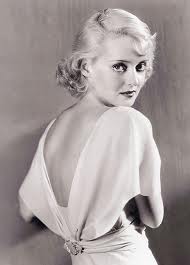 Davis appeared in Dangerous (1935) as a troubled actress and received very good reviews. E. Arnot Robertson wrote in Picture Post, “I think Bette Davis would probably have been burned as a witch if she had lived two or three hundred years ago. She gives the curious feeling of being charged with power which can find no ordinary outlet.” The New York Times hailed her as “becoming one of the most interesting of our screen actresses.” She won the Academy Award for Best Actress for the role, but commented it was belated recognition for Of Human Bondage, calling the award a “consolation prize.” For the rest of her life, Davis maintained that she gave the statue its familiar name of “Oscar” because its posterior resembled that of her husband, whose middle name was Oscar, although her claim has been disputed by the Academy of Motion Picture Arts and Sciences, among others.
Davis appeared in Dangerous (1935) as a troubled actress and received very good reviews. E. Arnot Robertson wrote in Picture Post, “I think Bette Davis would probably have been burned as a witch if she had lived two or three hundred years ago. She gives the curious feeling of being charged with power which can find no ordinary outlet.” The New York Times hailed her as “becoming one of the most interesting of our screen actresses.” She won the Academy Award for Best Actress for the role, but commented it was belated recognition for Of Human Bondage, calling the award a “consolation prize.” For the rest of her life, Davis maintained that she gave the statue its familiar name of “Oscar” because its posterior resembled that of her husband, whose middle name was Oscar, although her claim has been disputed by the Academy of Motion Picture Arts and Sciences, among others.
In her next film, The Petrified Forest (1936), Davis co-starred with Leslie Howard and Humphrey Bogart, but Bogart, in his first important role, received most of the critics’ praise. Davis appeared in several films over the next two years but most were poorly received.
Legal case
 Davis in a publicity portrait for Warner Bros., around the time she tried to free herself from the studio by taking them to court.
Davis in a publicity portrait for Warner Bros., around the time she tried to free herself from the studio by taking them to court.
Convinced that her career was being damaged by a succession of mediocre films, Davis accepted an offer in 1936 to appear in two films in Britain. Knowing that she was breaching her contract with Warner Bros., she fled to Canada to avoid legal papers being served upon her. Eventually, Davis brought her case to court in Britain, hoping to get out of her contract with Warner Bros. She later recalled the opening statement of the barrister, Sir Patrick Hastings, who represented Warner Bros. Hastings urged the court to “come to the conclusion that this is rather a naughty young lady and that what she wants is more money”. He mocked Davis’s description of her contract as “slavery” by stating, incorrectly, that she was being paid $1,350 per week. He remarked, “if anybody wants to put me into perpetual servitude on the basis of that remuneration, I shall prepare to consider it.” The British press offered little support to Davis, and portrayed her as overpaid and ungrateful.
Davis explained her viewpoint to a journalist, saying “I knew that, if I continued to appear in any more mediocre pictures, I would have no career left worth fighting for.” Davis’s counsel presented her complaints—that she could be suspended without pay for refusing a part, with the period of suspension added to her contract, that she could be called upon to play any part within her abilities regardless of her personal beliefs, that she could be required to support a political party against her beliefs, and that her image and likeness could be displayed in any manner deemed applicable by the studio. Jack Warner testified, and was asked, “Whatever part you choose to call upon her to play, if she thinks she can play it, whether it is distasteful and cheap, she has to play it?” Warner replied, “Yes, she must play it.” The case, decided by Branson J. in the English High Court, was reported as Warner Bros. Studios Incorporated v. Nelson in [1937] 1 KB 209. Davis lost the case and returned to Hollywood, in debt and without income, to resume her career. Olivia de Havilland mounted a similar case in 1943 and won.
Success with Warner Bros. (1937–1941)
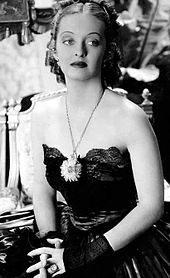 Jezebel (1938) was Davis’s second Academy Award-winning performance
Jezebel (1938) was Davis’s second Academy Award-winning performance
Davis began work on Marked Woman (1937), as a prostitute in a contemporary gangster drama inspired by the case of Lucky Luciano. For her performance in the film she was awarded the Volpi Cup at the 1937Venice Film Festival. Her next picture was Jezebel (1938), and during production Davis entered a relationship with director William Wyler. She later described him as the “love of my life”, and said that making the film with him was “the time in my life of my most perfect happiness.” The film was a success, and Davis’s performance as a spoiled Southern belle earned her a second Academy Award, which led to speculation in the press that she would be chosen to play a similar character, Scarlett O’Hara, in Gone with the Wind. Davis expressed her desire to play Scarlett, and while David O. Selznick was conducting a search for the actress to play the role, a radio poll named her as the audience favorite. Warner offered her services to Selznick as part of a deal that also included Errol Flynn and Olivia de Havilland, but Selznick did not consider Davis as suitable, and rejected the offer, while Davis did not want Flynn cast as Rhett Butler.
Jezebel marked the beginning of the most successful phase of Davis’s career, and over the next few years she was listed in the annual “Quigley Poll of the Top Ten Money Making Stars”, which was compiled from the votes of movie exhibitors throughout the U.S. for the stars that had generated the most revenue in their theaters over the previous year. In contrast to Davis’s success, her husband, Ham Nelson, had failed to establish a career for himself, and their relationship faltered. In 1938, Nelson obtained evidence that Davis was engaged in a sexual relationship with Howard Hughes and subsequently filed for divorce citing Davis’s “cruel and inhuman manner.”
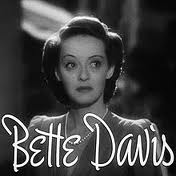 She was emotional during the making of her next film, Dark Victory (1939), and considered abandoning it until the producer Hal B. Wallis convinced her to channel her despair into her acting. The film became one of the highest grossing films of the year, and the role of Judith Traherne brought her an Academy Award nomination. In later years, Davis cited this performance as her personal favorite. She appeared in three other box office hits in 1939, The Old Maid with Miriam Hopkins, Juarez with Paul Muni and The Private Lives of Elizabeth and Essex with Errol Flynn. The latter was her first color film and her only color film made during the height of her career. To play the elderly Elizabeth I of England, Davis shaved her hairline and eyebrows. During filming she was visited on the set by the actor Charles Laughton. She commented that she had a “nerve” playing a woman in her sixties, to which Laughton replied, “Never not dare to hang yourself. That’s the only way you grow in your profession. You must continually attempt things that you think are beyond you, or you get into a complete rut.” Recalling the episode many years later, Davis remarked that Laughton’s advice had influenced her throughout her career.
She was emotional during the making of her next film, Dark Victory (1939), and considered abandoning it until the producer Hal B. Wallis convinced her to channel her despair into her acting. The film became one of the highest grossing films of the year, and the role of Judith Traherne brought her an Academy Award nomination. In later years, Davis cited this performance as her personal favorite. She appeared in three other box office hits in 1939, The Old Maid with Miriam Hopkins, Juarez with Paul Muni and The Private Lives of Elizabeth and Essex with Errol Flynn. The latter was her first color film and her only color film made during the height of her career. To play the elderly Elizabeth I of England, Davis shaved her hairline and eyebrows. During filming she was visited on the set by the actor Charles Laughton. She commented that she had a “nerve” playing a woman in her sixties, to which Laughton replied, “Never not dare to hang yourself. That’s the only way you grow in your profession. You must continually attempt things that you think are beyond you, or you get into a complete rut.” Recalling the episode many years later, Davis remarked that Laughton’s advice had influenced her throughout her career.
 Davis often played unlikable characters, such as Regina Giddens in The Little Foxes (1941).
Davis often played unlikable characters, such as Regina Giddens in The Little Foxes (1941).
By this time, Davis was Warner Bros.’ most profitable star, and she was given the most important of their female leading roles. Her image was considered with more care; although she continued to play character roles, she was often filmed in close-ups that emphasized her distinctive eyes. All This and Heaven Too (1940) was the most financially successful film of Davis’s career to that point, while The Letter (1940) was considered “one of the best pictures of the year” by The Hollywood Reporter, and Davis won admiration for her portrayal of an adulterous killer, a role originated by famed actress Katharine Cornell. During this time, she was in a relationship with her former costar George Brent, who proposed marriage. Davis refused, as she had met Arthur Farnsworth, a New England innkeeper. Davis and Farnsworth were married at Home Ranch, in Lake Montezuma, Arizona, in December 1940.
In January 1941, Davis became the first female president of the Academy of Motion Picture Arts and Sciences but antagonized the committee members with her brash manner and radical proposals. Faced with the disapproval and resistance of the committee, Davis resigned, and was succeeded by Jean Hersholt, who implemented the changes she had suggested. Davis starred in three movies in 1941, the first being The Great Lie, opposite George Brent. It was a refreshingly different role for Davis, as she played a kind, sympathetic character. Brent tickled Davis during many of the film’s scenes, which allowed the audience, used to Davis’ strong-willed character, a rare glimpse of her succumbing to giggles and squirms. William Wyler directed Davis for the third time in Lillian Hellman‘s The Little Foxes (RKO, 1941), but they clashed over the character of Regina Giddens. Taking a role originally played on stage by Tallulah Bankhead, Davis felt Bankhead’s original interpretation was appropriate and followed Hellman’s intent, but Wyler wanted her to soften the character. Davis refused to compromise. She received another Academy Award nomination for her performance, and never worked with Wyler again.
War effort and personal tragedy (1942–1944)
Following the attack on Pearl Harbor, Davis spent the early months of 1942 selling war bonds. After Jack Warner criticized her tendency to cajole crowds into buying, she reminded him that her audiences responded most strongly to her “bitch” performances. She sold two million dollars worth of bonds in two days, as well as a picture of herself in Jezebel for $250,000. She also performed for black regiments as the only white member of an acting troupe formed by Hattie McDaniel, which included Lena Horne and Ethel Waters.
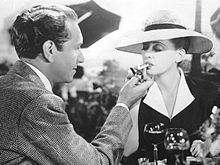 Paul Henreid lights Davis’s cigarette in Now, Voyager (1942): though the iconic scene comes later, this foreshadows it.
Paul Henreid lights Davis’s cigarette in Now, Voyager (1942): though the iconic scene comes later, this foreshadows it.
At John Garfield‘s suggestion of opening a servicemen’s club in Hollywood, Davis—with the aid of Warner, Cary Grant and Jule Styne—transformed an old nightclub into the Hollywood Canteen, which opened on October 3, 1942. Hollywood’s most important stars volunteered to entertain servicemen. Davis ensured that every night there would be a few important “names” for the visiting soldiers to meet.[37] She appeared as herself in the film Hollywood Canteen (1944), which used the canteen as the setting for a fictional story. Davis later commented, “There are few accomplishments in my life that I am sincerely proud of. The Hollywood Canteen is one of them.” In 1980, she was awarded the Distinguished Civilian Service Medal, the United States Department of Defense‘s highest civilian award, for her work with the Hollywood Canteen.
Davis showed little interest in the film Now, Voyager (1942) until Hal Wallis advised her that female audiences needed romantic dramas to distract them from the reality of their lives. It became one of the best known of her “women’s pictures.” In one of the film’s most imitated scenes, Paul Henreid lights two cigarettes as he stares into Davis’s eyes and passes one to her. Film reviewers complimented Davis on her performance, the National Board of Review commenting that she gave the film “a dignity not fully warranted by the script.”
During the early 1940s, several of Davis’s film choices were influenced by the war, such as Watch on the Rhine (1943), by Lillian Hellman, and Thank Your Lucky Stars (1943), a lighthearted all-star musical cavalcade, with each of the featured stars donating their fee to the Hollywood Canteen. Davis performed a novelty song, “They’re Either Too Young or Too Old”, which became a hit record after the film’s release. Old Acquaintance (1943) reunited her with Miriam Hopkins in a story of two old friends who deal with the tensions created when one of them becomes a successful novelist. Davis felt that Hopkins tried to upstage her throughout the film. Director Vincent Sherman recalled the intense competitiveness and animosity between the two actresses, and Davis often joked that she held back nothing in a scene in which she was required to shake Hopkins in a fit of anger.
 In August 1943, Davis’s husband, Arthur Farnsworth, collapsed while walking along a Hollywood street and died two days later. An autopsy revealed that his fall had been caused by a skull fracture he had suffered two weeks earlier. Davis testified before an inquest that she knew of no event that might have caused the injury. A finding of accidental death was reached. Highly distraught, Davis attempted to withdraw from her next film Mr. Skeffington (1944); but Jack Warner, who had halted production following Farnsworth’s death, convinced her to continue. Although she had gained a reputation for being forthright and demanding, her behavior during filming of Mr. Skeffington was erratic and out of character. She alienated Vincent Sherman by refusing to film certain scenes and insisting that some sets be rebuilt. She improvised dialogue, causing confusion among other actors, and infuriated the writer, Julius Epstein, who was called upon to rewrite scenes at her whim. Davis later explained her actions with the observation, “when I was most unhappy I lashed out rather than whined”. Some reviewers criticized Davis for the excess of her performance; James Agee wrote that she “demonstrates the horrors of egocentricity on a marathonic scale;” but despite the mixed reviews, she received another Academy Award nomination.
In August 1943, Davis’s husband, Arthur Farnsworth, collapsed while walking along a Hollywood street and died two days later. An autopsy revealed that his fall had been caused by a skull fracture he had suffered two weeks earlier. Davis testified before an inquest that she knew of no event that might have caused the injury. A finding of accidental death was reached. Highly distraught, Davis attempted to withdraw from her next film Mr. Skeffington (1944); but Jack Warner, who had halted production following Farnsworth’s death, convinced her to continue. Although she had gained a reputation for being forthright and demanding, her behavior during filming of Mr. Skeffington was erratic and out of character. She alienated Vincent Sherman by refusing to film certain scenes and insisting that some sets be rebuilt. She improvised dialogue, causing confusion among other actors, and infuriated the writer, Julius Epstein, who was called upon to rewrite scenes at her whim. Davis later explained her actions with the observation, “when I was most unhappy I lashed out rather than whined”. Some reviewers criticized Davis for the excess of her performance; James Agee wrote that she “demonstrates the horrors of egocentricity on a marathonic scale;” but despite the mixed reviews, she received another Academy Award nomination.

